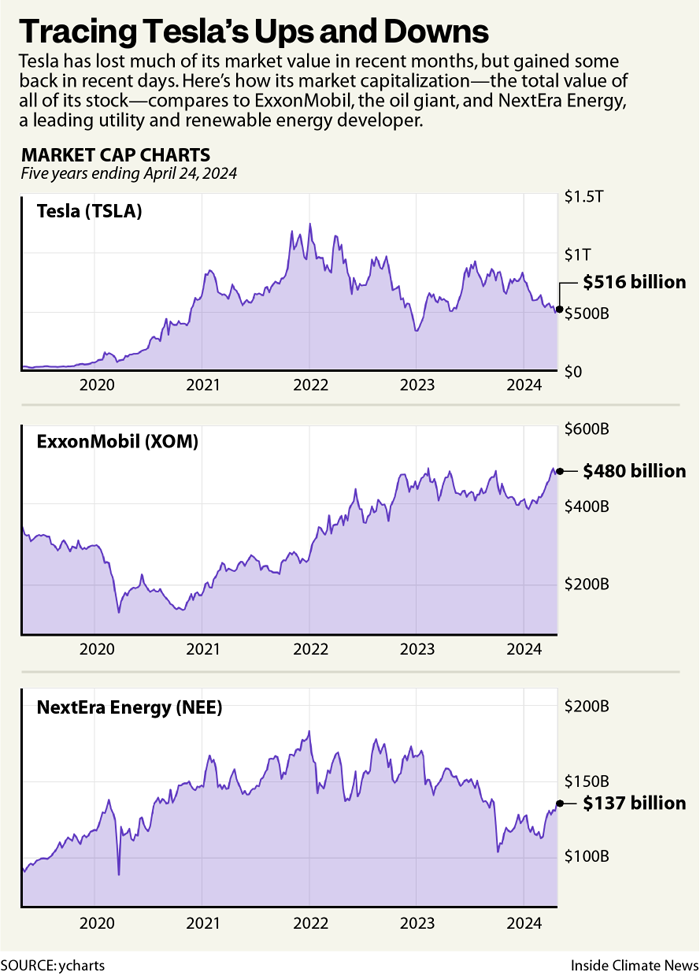Tesla Fell Behind, Then Leapt Ahead of ExxonMobil in Market Value This Week
One of the sideshows in a wild week for Tesla is how its market capitalization tumbled behind and then jumped back ahead of ExxonMobil.
The fact that this is even a topic of conversation is a testament to how much Tesla has fallen, with sluggish sales and a vehicle lineup that is overdue for an update in the face of now-formidable competition. Tesla’s market capitalization—the sum of the value of all of its stock—had plummeted from a high of more than $1.2 trillion on Jan. 3, 2022, to $452 billion on Monday.
Tesla regained value later this week following a conference call in which the company affirmed its plans to develop low-cost models. As I’m writing this on Wednesday, Tesla’s market cap is $516 billion.
We’re hiring!
Please take a look at the new openings in our newsroom.
See jobsMeanwhile, ExxonMobil and the oil and gas industry have been on a hot streak ever since Russia invaded Ukraine in February 2022, benefiting from geopolitical instability that has boosted prices of oil and gas, an instability that has grown with the current conflict in the Middle East. ExxonMobil’s market cap has gone from less than $300 billion before the invasion to $480 billion as of Wednesday.
A lot could be said about the recent decline of Tesla and rise of ExxonMobil, but let me warn you against making grand statements about the trajectory of the energy transition.
I have some experience with this, having noted in 2020 how ExxonMobil’s value, then bottoming out during an extremely rough patch, had fallen below that of NextEra Energy, the Florida-based utility and renewable energy developer.
In the time since, ExxonMobil’s value has grown by a lot and NextEra’s is about the same after some ups and downs. It looks silly, in hindsight, to have talked about the two companies in the same breath.
At this time, two things are true: First, the energy transition has progressed a lot since 2020, and NextEra is an important company in the energy transition. Second, ExxonMobil has been a much better stock to own than NextEra in recent years, from a financial perspective.

A larger point is that it’s tricky to compare the financial performance and market value of companies in different industries, said Pavel Molchanov, an analyst for the financial services company Raymond James.
“While comparing Tesla and Exxon might be a fun parlor game, let’s be clear that this is not some sort of competition over which company is ‘better,’” he said in an email. “Corporate market caps are influenced by a very wide range of variables, many of which are outside management’s control.”
He said oil prices are closely tied to geopolitical factors and have little to do with anything ExxonMobil or any other oil company has accomplished by itself.
At the same time, the EV market is facing some short-term headwinds due to factors such as high interest rates that are making it more expensive to get car loans, he said.
Tesla also has its own issues, including a volatile CEO whose online comments are alienating parts of his customer base, as the Wall Street Journal has reported, citing polling from Strategic Vision. The company’s most recent new product, the Cybertruck, has gotten rough reviews and its top-selling models, the Model Y and Model 3, have gone a long time without a major redesign. And, Tesla has gone from being one of the only makers of EVs to having lots of competition.
But Tesla’s specific problems don’t constitute a victory for the fossil fuel economy, said Tom Sanzillo, director of financial analysis for the Institute for Energy Economics and Financial Analysis, a nonprofit that does research in support of the energy transition.
“The energy transition is much bigger than Tesla,” he said.
He has written extensively about how major oil companies such as ExxonMobil are not good investments because they don’t have workable plans to exist in the low-carbon world that is coming. So what does he think of the increase in market value of those companies?
“That value is really a function of the geopolitical fights that are going on, hardly something that you would consider to be a part of an investment calculus that would be stable,” he said.
The big picture comes into focus when looking at global trends in how money is being spent. EV market share continues to grow despite current challenges, with the International Energy Agency saying this week that global sales will grow to 17 million vehicles this year, an increase of about 20 percent from the prior year. EVs would be about one out of every five cars or light trucks sold.
And, as I’ve cited before, global investment in energy transition technologies was $1.8 trillion last year compared to $1.1 trillion for fossil fuels, according to BloombergNEF.
The gap has widened by a lot since 2020, and that matters more than how investors respond to Tesla’s latest pronouncement or how much profit ExxonMobil made in the last quarter.
Other stories about the energy transition to take note of this week:
UAW Conquers Hostile Political Terrain With Win at Tennessee Volkswagen Plant: The United Auto Workers won a huge victory on Friday when thousands of workers at a Volkswagen plant in Tennessee voted to join the union, despite attempts from state Republicans to discourage the effort, as Nick Niedzwiadek reports for Politico. The UAW’s campaign drew on momentum from last year’s strike at the Big Three car companies. VW Chattanooga, where workers make models including the ID.4, an all-electric crossover, is the company’s flagship in the United States.
New York Says It Is Not Moving Forward With Three Offshore Wind Farms: New York’s state government said it will not move forward with three offshore wind farms after General Electric Vernova changed its turbine design, which the state said “materially altered” plans for the three projects. The projects were to use 18-megawatt wind turbines, but then GE Vernova decided to not to make that turbine in favor of a smaller design, as Nichola Groom, Laila Kearney, Timothy Gardner and Nicole Jao report for Reuters. The change in turbines caused enough impact on the financial and operational basics that the New York State Research and Development Authority said it would not sign final contracts. The office said it intends to hold a competitive bidding process to move forward with development in the available offshore wind areas. This is the latest in a series of wind project cancellations, coming as developers face challenges from high interest rates and other changes in the market.
Chinese Export Surge Clouds U.S. Hopes of a Domestic Solar Boom: Concerns are rippling across the U.S. solar industry and within the Biden administration about whether the push to set up a domestic solar manufacturing industry can succeed against cheaper imports from China. In February, CubicPV said it was abandoning plans to build a solar component factory in the United States because of cost disadvantages with Chinese imports, a decision that underscores the industry’s worry about long-term competitive issues, as Alan Rappeport reports for the New York Times.
IRA’s Solar for All Program Will Install Nearly 1 Million Systems in U.S.: For people who have spent their careers trying to expand access to rooftop solar energy, the announcement on Monday of $7 billion worth of project support from the Biden administration is almost unfathomable in its size and scope, as I wrote for ICN. Money from the Solar for All program, which is part of the Inflation Reduction Act, will go to 60 recipients that include state and Tribal governments and nonprofit organizations. For 25 states and territories, this is the first time they’re getting low-income solar programs, as Alison Takemura reports for Canary Media. Most of the newcomers are Republican-leaning states, such as Arkansas, Arizona, Idaho, Missouri, Nebraska, North Dakota and South Dakota.
Western States Could Make Billions Selling Renewable Energy, But They’ll Need a Lot More Regional Transmission Lines: Colorado, Montana, New Mexico and Wyoming could vastly increase their incomes from exporting renewable electricity, but only if the region can expand the network of the transmission lines that would deliver the power, as my colleague Wyatt Myskow reports for ICN. RMI, the research and advocacy group, published a report that looks at the potential for expanding clean energy development and how the states need to coordinate to be able to effectively build the power lines that are needed.
Inside Clean Energy is ICN’s weekly bulletin of news and analysis about the energy transition. Send news tips and questions to [email protected].
Share this article
Disclaimer: The copyright of this article belongs to the original author. Reposting this article is solely for the purpose of information dissemination and does not constitute any investment advice. If there is any infringement, please contact us immediately. We will make corrections or deletions as necessary. Thank you.







